|
|
|
|
|
|
|
Achi-Kochi Japan
Showing many places to visit and foods to eat in Japan
|
|
|
|
|
|
|
|
|
|
|
|
|
Japan
> Shikoku region
> Matsuyama City
|
|
|
|
|
|
|
Matsuyama City
Ehime Pref., Shikoku ( Achi-Kochi Japan )
|
|
|
|
|
|
|
|
|
|
|
|
|
( "Achi-Kochi" in Japanese means "Here and there" in English. )
Matsuyama City

Matsuyama City ( above ), located in the north-west of Shikoku Region, is the capital city of Ehime Prefecture and used to be the capital city of a feudal domain, Matsuyama Domain during Tokugawa Period ( ==> A History of Japan vol.2 Samurai Age ). In the city where more than half a million people live, Matsuyama-jo Castle and Dogo Onsen hot springs are very famous and popular among many tourists.
|
|
Matsuyama-jo Castle

In A.D.1602, Yoshiaki Kato, a feudal lord, started the construction of the Matsuyama-jo Castle and he named its castle town "Matsuyama" the next year. Since then on, the castle town had developed and now Matsuyama is the largest city in Shikoku Region and Matsuyama-jo Castle overlooks the city. The above photo shows the main keep, turrets and stone walls on the mountain as well as moat at the foot of the mountain.
|
|
High Stone Walls, Gates and Turrets
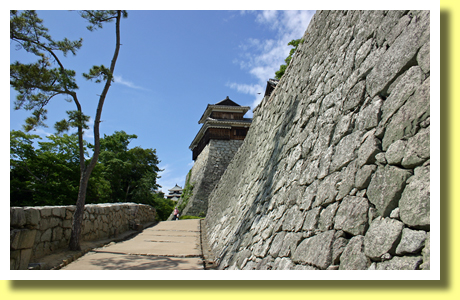
The Main Keep of Matsuyama-jo Castle is surrounded by high stone walls, gates and turrets ( above ). In the site of the castle, 21 original buildings have survived, all of which are designated National Important Cultural Properties of Japan, including the main keep. Also the castle site is one of National Historic Sites of Japan. In addition, 22 buildings have been reconstructed.
|
|
Main Keep and Sakura
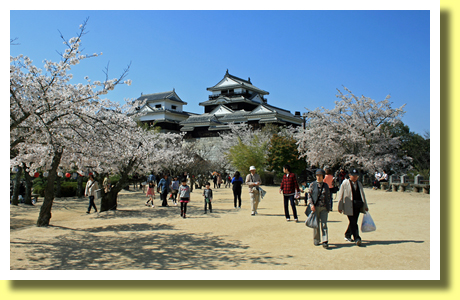
On the top of the mountain ( 132 meter-high ), there is the main keep of Matsuyama-jo Castle ( above ). The main keep is surrounded by many cherry trees. Tourists, visiting Matsuyama in the season of Hanami ( Sakura Viewing ), could enjoy lots of Sakura ( cherry blossoms ) in the site of the castle. The castle is one of the best Hanami places.
|
|
Main Keep Complex
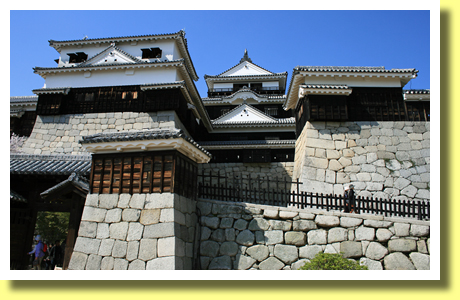
The main keep ( above ) of Matsuyama-jo Castle is connected to and defended by the secondary keep and a few turrets. In A.D.1784, the main keep was burnt down by lightning. In A.D.1854 reconstructed was the main keep, which overlooks the city now. Matsuyama-jo is one of twelve original castles, among which Himeji-jo Castle has a main keep complex as well.
|
|
Overlooking

Tourists could walk inside the main keep complex, where exhibited are swords, armour and many more related to the history of the castle and the city. Also on the top of the main keep, tourists could enjoy overlooking the site of the castle and the city ( above ).
|
|
Up To Main Keep
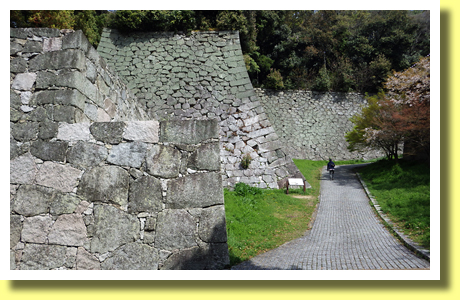
Though a ropeway and a chair lift would help tourists to go up to the main keep of the castle, it could be recommended to walk up ( above ) to the top of the mountain. It takes 20-30 minutes from the foot of the mountain to the top.
|
|
Dogo Onsen
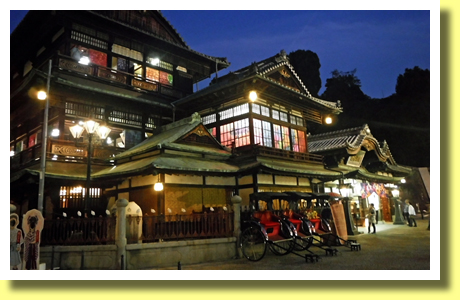
There is Dogo Onsen ( Dogo hot springs ) in Matsuyama City. Dogo Onsen is one of the oldest, most famous and most popular hot springs in Japan. Especially Dogo Onsen Honkan ( above ), a public bathhouse, is very popular among tourists.
|
|
Dogo Onsen Honkan
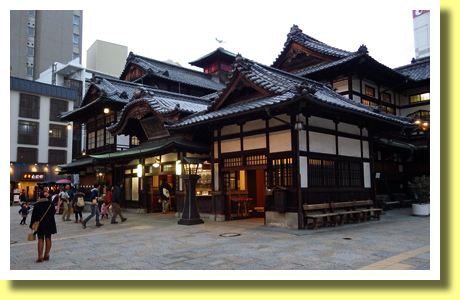
Dogo Onsen Honkan ( above ) was built in A.D.1894 and is designated National Important Cultural Property of Japan. Though the bathhouse is old, it is very popular among tourists and local people, some of whom wait for its opening at 06:00 am everyday. It is closed at 11:00 pm.
There are a few more public onsen bathhouses in the area. Also Dogo Onsen Honkan is surrounded by many hotels and onsen ryokan ( Japanese style accommodation ), in which tourists could enjoy onsen baths.
|
|
Yushin-den
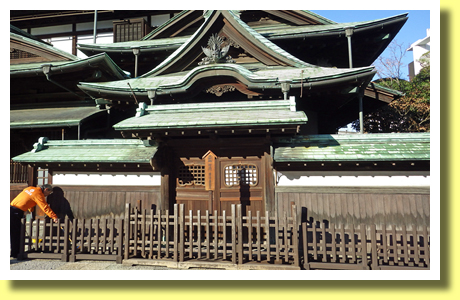
There is the Imperial bath called "Yushin-den" in Dogo Onsen Honkan. Yushin-den was built in A.D.1899 for the Imperial Family. The above photo shows the entrance of Yushin-den, through which the members of the Imperial Family could enter.
It is said that the history of Dogo Onsen is longer than 3,000 years, during which members of the Imeprial Family visited the Onsen, such as Emperor Keiko in the 1-2nd century, Emperor Chuai in the 2nd century, Empress Jingu in the 2-3rd century, Prince Shotoku in the 6th century, Empress Saime in the 7th century, Prince Naka-no-Oe in the 7th century and so on ( ==> A History of Japan vol.1 Formation of Japan ).
|
|
Isaniwa-jinja Shrine
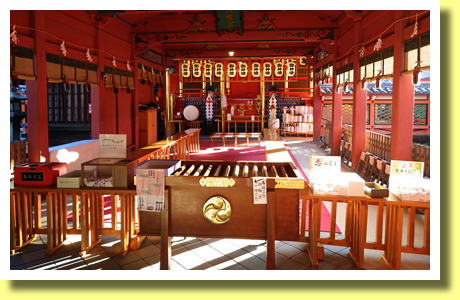
Isaniwa-jinja Shrine ( above ) is located near Dogo Onsen Honkan. Though its history is longer than 1,000 years, the main hall was built by the feudal lord in A.D.1667 and is one of the designated National Important Cultural Properties of Japan.
|
|
Ishite-ji Temple

Also Ishite-ji Temple is located near Dogo Onsen and is as popular among tourists as Isaniwa-jinja Shrine is. The temple was founded in A.D.728. Many buildings of the temple were burnt down by the fires of war in A.D.1566 but the Main Hall ( above ), Nio-mon Gate, a three storied pagoda and some more survived.
The Main Hall and the three storied pagoda are the designated National Important Cultural Properties of Japan and Nio-mon Gate is the designated National Treasure of Japan. Ishite-ji is Temple No.51 on the Shikoku Henro Pilgrimage.
|
|
Dogo Koen and Ruins of Yuzuki-jo Castle

Ruins of Yuzuki-jo Castle is located near Dogo Onsen. The castle was built by the Kono Clan, who ruled the area through the 14th-16th centuries. In A.D.1585 they were overthrown and the castle was abandoned. There remain some moats and earthworks ( above ) and the castle site is an designated National Historic Site.
The castle site is now a part of Dogo Koen ( Dogo Park ) where many prople enjoy Hanami ( Sakura Viewing ) in the season of Sakura ( cherry blossoms ). There is a museum which exhibits those excavated in the site. Also there is the Matsuyama Municipal Shiki Memorial Museum which exhibits those related to haiku and Shiki Masaoka, a local and famous haiku poet.
|
|
Tai-meshi
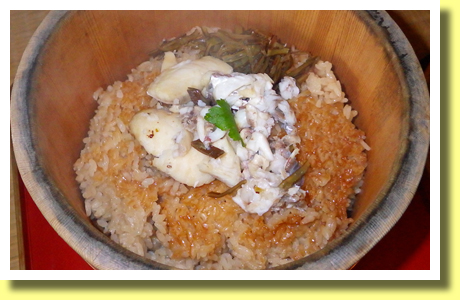
Ehime Prefecture is famous for Tai ( sea bream or red snapper ) and there are many restaurants which serve Tai-meshi ( above ). Tai-meshi, boiled rice with sea bream, is one of the local specialty seafoods so famous and popular among tourists.
|
|
Nabeyaki-udon
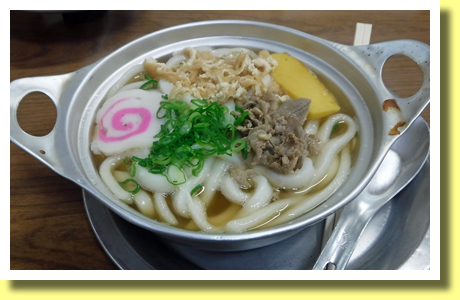
Also Nabeyaki-udon ( above ) is one of the local specialties which local people love. Nabeyaki-udon is Japanese wheat-flour noodles served in a pan. Nabeyaki-udon served in Matsuyama is not so chewy as Sanuki Udon served in Kagawa Prefecture is. In Matsuyama there are many restaurants serving Nabeyaki-udon, among which Kotori and Asahi are famous and long standing.
|
Copyright (c) 2021 Achi-Kochi Zanmai Co., Ltd.
|